


Thai Spa & Traditional Thai Massage
Thai Secret of Sensual Healing
Thai Herbal
Thai herbal Traditional Thai herbs are affiliated with the Thai culture and have become integrated in the way of living of the Thai people lived through out the agesfor a long time. due toSince Thailand’s has plentifuly of resources and forestry. FurthermoreBesides, each region represents its own uniquehas different climates and terrain types, which are the sources for the of a variety of herbs and production available in each locations. This These resources mean thatcan meet the world market needs forof natural products can be efficiently met very well. Health products and Thai herbs are well known for a wide variety ofly usesd in the health care business, through from direct consumption in the form of food, medicine or an ingredient in cosmetic products, tothe products used in traditional Thai Spa and treatments. |
|
Soap Nut Scientific name : Sapindus Emarginatus Wall. Vernacular name : Prar Karm Dee Kwai This ancient beauty ingredient derives its unusual name from the foam that is produced by crushing the fruit. For centuries Thai women have used the fruit to darken and thicken their hair. It is also believed to prevent hair loss. |
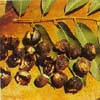 |
Kaffir Lime Scientific name : Citrus Hystrix DC. Vernacular name : Ma Krout This leaf is used in Thai Cuisine to add a lemony flavour to soups and salads, while the zest is a popular ingredient in herbal compresses and the oil is used in aromatherapy. The fresh fruit is an all-purpose aid to hair beauty -- making tresses soft and silky. |
 |
Ivy Gourd Leaf Vernacular name : Tam Lueng Scientific name : Coccinia Grandis This attractive creeper is an age-old Thai medicinal ingredient used to soothe skin irritations, and is also a tasty ingredient in clear soups. Thais also found use for its moisturising properties as a beauty ingredient in body wraps and facial gels (it is good for use on normal skins.) The ripe fruit is high in vitamins, but its use is becoming rarer, because the fruit is tiny and difficult to find. |
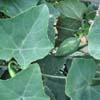 |
Butterfly Pea Flower Scientific name : Clitorea Ternatea Vernacular name : An Chan For centuries Thai women have used the juices of anchan, a dark purple flower, to promote dark, lustrous, thick hair. It was also rubbed into babies' eyebrows to make the brows grow thick and long. The flower is rich in Bioflavinoid, an ingredient in modern-day hair products that stimulate hair growth. |
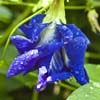 |
Coconut Scientific name : Cocos Nucifera Vernacular name : Ma Praw The coconut has myriad uses in Thailand. When the fruit is ripe, the hard, white flesh is grated, soaked in water and squeezed to produce coconut milk, an important ingredient in Thai curries and desserts. The ripe fruit contains a juice that makes a refreshing drink in hot weather. Oil of copra, extracted from the dried meat, is used as an ingredient in the cosmetics industry. Coconut oil was used in the olden days to treat stiff joints; the oil was heated with prai and the mixture rubbed in. |
 |
Rice Scientific name : Oryza Sativa Vernacular name : Khao Rice is the lifeblood of Thai life. As the key crop and main food staple, it is highly revered in traditional culture and is protected by a goddess called Jao Mae Po Sob. The monarch officiates at the annual Royal Ploughing Ceremony, which marks the first day of the planting season. In the past Thais used rice to ward off ghosts -- chanting monks endowed sacred properties onto rice that was then thrown on unwelcome spirits to chase them away. Many modern-day spas have adopted raw rice as an effective ingredient in natural body scrubs. |
 |
Sweet Basil Scientific name : Ocimum Basilicum Vernacular name : Ho Ra Pha This fragrant, spicy herb is eaten raw or used as a flavouring in many local dishes. It has medicinal properties and is used in traditional healing to help reduce mucous in colds and flu, eliminate gas and aid digestion. As an aromatherapy ingredient, the essential oil of the basil plant is used to refresh the senses and relieve tiredness. |
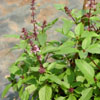 |
Plai Scientific name : Zingiber Cassumunar Roxb. Vernacular name : Plai Plai is a rhizome of the ginger family and has been used for centuries as a herbal ingredient in hot compresses that are applied to relieve muscular aches and pains. It is also a natural emollient and has been used by generations of Thai women to tone and soften the skin. Prai oil is also popular as a scalp conditioner and is used in aromatherapy. |
 |
Ginger Scientific name : Zingiber sp Vernacular name : Keng Thais use both the young and mature ginger rhizome in many foods and beverages. Ginger is known as a stimulant that has a heating effect on the body. Taken as a herbal drink, it helps reduce gas and aids digestion. Traditionally, Thai mothers used a ginger treatment if their baby had an upset stomach. A paste of crushed ginger and rice liquor was rubbed on to the baby's tummy to soothe the stomach discomfort and reduce any gas. In aromatherapy, the essential oil is used to boost circulation and ease stiff muscles. |
 |
Galangal Scientific name : Languas Galanga Vernacular name : Kar This rhizome is often mistaken for ginger, but its whitish color with a pinkish tinge identifies it as galangal a popular ingredient in Thai soups and curries for its fragrant, tangy aroma. Though too pungent to be eaten raw, the fresh root is used in traditional medicine to relieve digestive ailments and cure skin diseases. Galangal finds its way into modern spa treatments as an ingredient in herbal body wraps. |
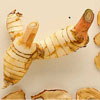 |
Turmeric Scientific name : Curcuma Domestica Vernacular name : Kha Min Chan This orange-coloured rhizome is dried and crushed to form a powdered spice and colouring for many kinds of food. Turmeric is one of the key ingredients in Thai healing concoctions. It is used in herbal medicine to treat stomach discomfort and in traditional cosmetics for skin care. When crushed, the oil the rhizome yields is an efficient natural moisturiser and it also has antiseptic properties. |
 |
Papaya Scientific name : Carica Papaya Vernacular name : Ma La Kor The ripe fruit contains the enzyme papain, which is known for its digestive properties. The bright orange fruit contains large amounts of Vitamins A and C, and acts as a digestive when eaten unripe, or a laxative when eaten ripe. It is also known to contain AHA, making it a popular and effective ingredient in body wrap treatments to exfoliate and smoothe the skin. |
 |
Nutmeg Scientific name : Myristica Fragrans Vernacular name : Jun Ted Though not a commonly used ingredient in Thai cosmetics or cuisine, this spice has medicinal uses in southern Thailand. Here, the oil is used in massage oil to soothe muscular aches and pains and stimulate the muscles. It has warm, spicy scent that relieves fatigue. |
 |
Lemon Grass Scientific name : Cymbopogon Citratus Vernacular name : Ta Khrai A signature ingredient in Thai cuisine, this grass-like herb has a sharp, fresh, lemony aroma, making it a favourite flavouring in food, drinks and cosmetics. As a medicinal herb, it was traditionally used to cure skin complaints and headaches, and was burnt to kill germs and repel insects. It is an ingredient in Thai herbal compresses for its soothing, while the aroma relieves stress. As an ingredient in a traditional herbal steam bath, it helps clear the head and soothe hangovers. |
 |
Lime Scientific name : Citurs sp Vernacular name : Ma Naw Lime is another signature ingredient in Thai cuisine: It is usually mixed with chilli and onions in soups and salads. As a spa ingredient, its acidity gives it the same qualities as tamarind, but it is used in smaller quantities due to its small size. The essential oil is used in aromatherapy to boost circulation and it is an effective insect repellent. All citrus oils are also used as energisers. |
 |
Tamarind Scientific name : Tamarindus Indica Vernacular name : Ma khaam The incredibly sour tamarind fruit is eaten in a variety of ways in Thai cuisine and it also has a variety of medicinal uses: the bark is used as an astringent the flowers can reduce blood pressure, and the fruit has laxative effect. A refreshing tamarind drink can relieve constipation. The leaves are used in herbal steams as the acidity is thought to help the skin absorb the other herbal ingredients faster. Traditionally, wet tamarind was used as a beauty product: its high AHA content makes it an effective natural exfoliator and it was put on the face and body to brighten and smoothe the skin. |
 |
Camphor Scientific name : Cinnamomum Camphora Vernacular name : Ka La Boon Extracted and processed from the camphor tree, kalaboon is a white powder-like substance with a cool, refreshingly minty smell used to ease and soothe repiration. The powder is used as an ingredient in Thai herbal baths and the leaves of the camphor tree and a vital ingredient in traditional herbal steams. |
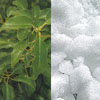 |
Cucumber Scientific name : Cucumis Sativus Vernacular name : Tang Kwa This crisp, refreshing vegetable has been used for hundreds of years as a face mask ingredient to help tone and moisturise the skin. Because of its high water content, chilled cucumber slices placed on the face provide immediate relief on a hot day. |
 |
Aloe Vera Scientific name : Aloe Vera syn. Aloe Barbadensis Vernacular name : Thais call this plant the "crocodile tail plant" due to the appearance of its tapering, spiky leaves. When the leaves or stalks are pierced, a refreshing, healing gel oozes out. If applied to the skin, it soothes burns and is also a natural skin softener. Aloe gel is an effective natural sunburn soother and it is also good for moisturising dry of flaky skin. |
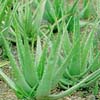 |
| by Thai Spa Book The Natural Asian Way To Health and Beauty | |
